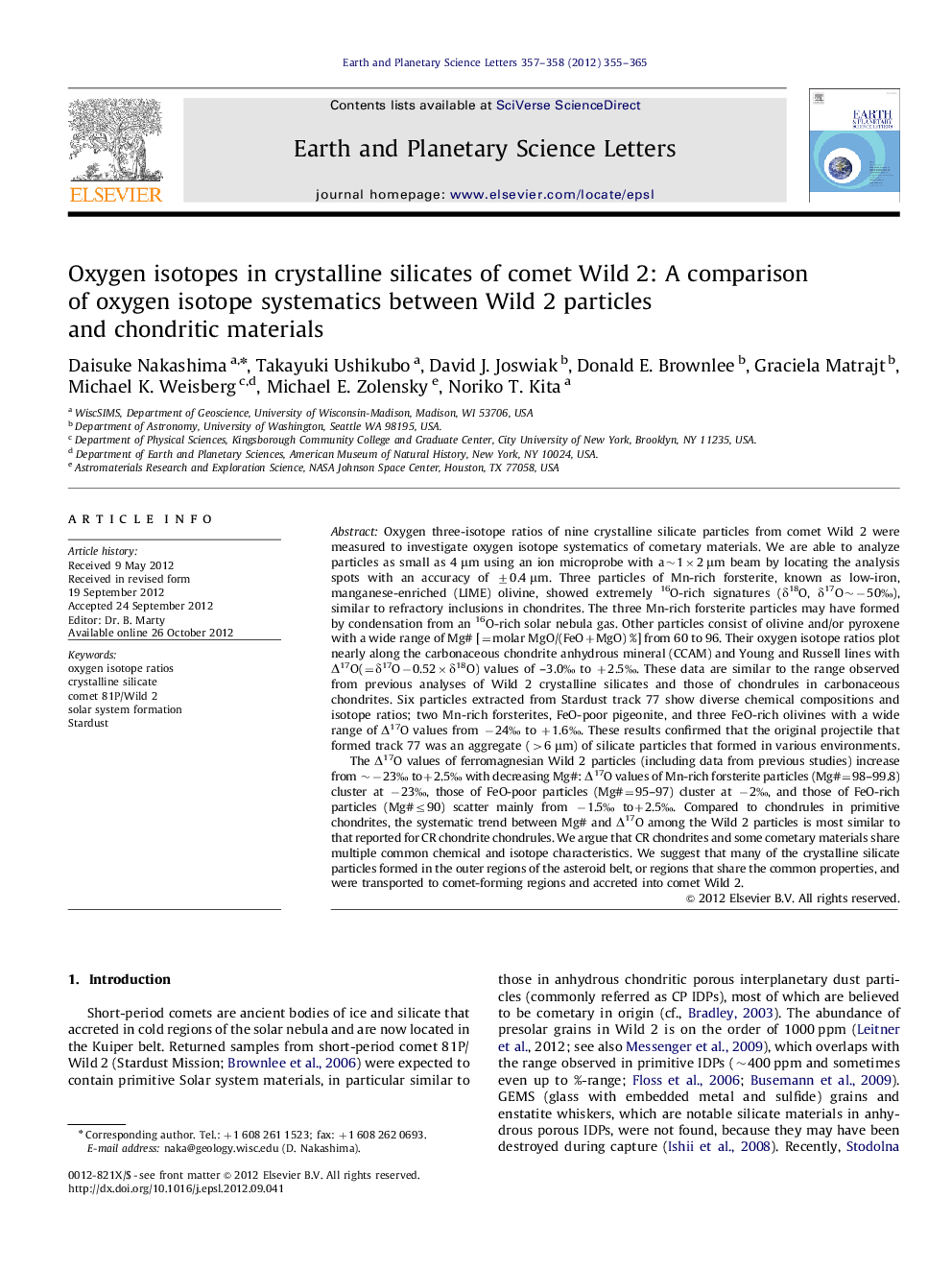| کد مقاله | کد نشریه | سال انتشار | مقاله انگلیسی | نسخه تمام متن |
|---|---|---|---|---|
| 4677307 | 1634794 | 2012 | 11 صفحه PDF | دانلود رایگان |

Oxygen three-isotope ratios of nine crystalline silicate particles from comet Wild 2 were measured to investigate oxygen isotope systematics of cometary materials. We are able to analyze particles as small as 4 μm using an ion microprobe with a∼1×2 μm beam by locating the analysis spots with an accuracy of ±0.4 μm. Three particles of Mn-rich forsterite, known as low-iron, manganese-enriched (LIME) olivine, showed extremely 16O-rich signatures (δ18O, δ17O∼−50‰), similar to refractory inclusions in chondrites. The three Mn-rich forsterite particles may have formed by condensation from an 16O-rich solar nebula gas. Other particles consist of olivine and/or pyroxene with a wide range of Mg# [=molar MgO/(FeO+MgO) %] from 60 to 96. Their oxygen isotope ratios plot nearly along the carbonaceous chondrite anhydrous mineral (CCAM) and Young and Russell lines with Δ17O(=δ17O−0.52×δ18O) values of –3.0‰ to +2.5‰. These data are similar to the range observed from previous analyses of Wild 2 crystalline silicates and those of chondrules in carbonaceous chondrites. Six particles extracted from Stardust track 77 show diverse chemical compositions and isotope ratios; two Mn-rich forsterites, FeO-poor pigeonite, and three FeO-rich olivines with a wide range of Δ17O values from −24‰ to +1.6‰. These results confirmed that the original projectile that formed track 77 was an aggregate (>6 μm) of silicate particles that formed in various environments.The Δ17O values of ferromagnesian Wild 2 particles (including data from previous studies) increase from ∼−23‰ to+2.5‰ with decreasing Mg#: Δ17O values of Mn-rich forsterite particles (Mg#=98–99.8) cluster at −23‰, those of FeO-poor particles (Mg#=95–97) cluster at −2‰, and those of FeO-rich particles (Mg#≤90) scatter mainly from −1.5‰ to+2.5‰. Compared to chondrules in primitive chondrites, the systematic trend between Mg# and Δ17O among the Wild 2 particles is most similar to that reported for CR chondrite chondrules. We argue that CR chondrites and some cometary materials share multiple common chemical and isotope characteristics. We suggest that many of the crystalline silicate particles formed in the outer regions of the asteroid belt, or regions that share the common properties, and were transported to comet-forming regions and accreted into comet Wild 2.
► We analyzed oxygen isotope ratios of nine crystalline silicates from comet Wild 2.
► Oxygen isotope ratios are highly variable: 16O-rich to 16O-poor.
► 16O-rich Mn-rich forsterites may be condensates from an 16O-rich solar nebula gas.
► Δ17O-Mg# trend of 16O-poor silicates resembles that of CR chondrite chondrules.
► Many of Wild 2 silicates may have been transported from the outer asteroid belt.
Journal: Earth and Planetary Science Letters - Volumes 357–358, 1 December 2012, Pages 355–365